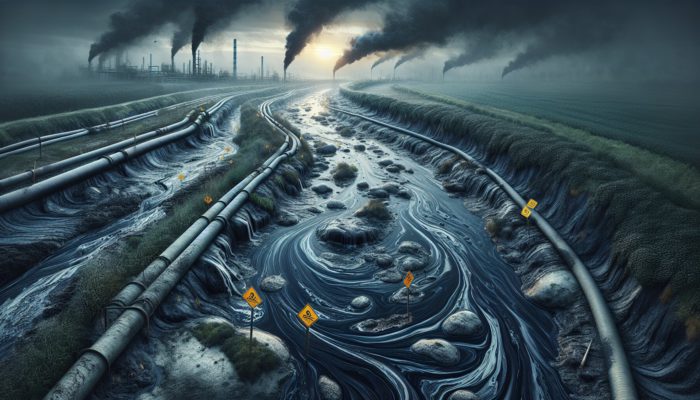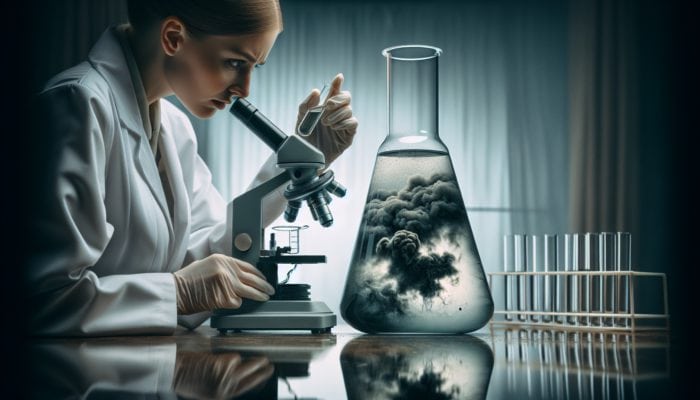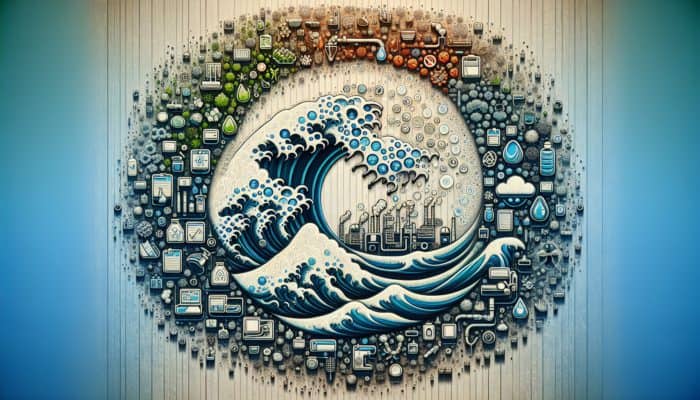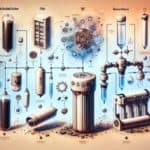Identifying the Key Sources of Water Contamination
Understanding Chemical Pollutants and Their Impact

Water Contamination Risks: Chemical pollutants are among the most significant contributors to global water contamination. These harmful substances typically originate from a range of sources, including industrial activities, agricultural runoff, and improper waste disposal practices, all of which can pose significant health and environmental risks. For instance, runoff from agricultural fields often contains fertilizers and pesticides, which can enter nearby rivers and lakes through surface runoff. Additionally, heavy metals, such as lead and mercury, can leach into groundwater from industrial discharges. To combat these issues, stricter regulations and improved agricultural management practices are vital. Notable examples of chemical pollutants include:
- Nitrates
- Phosphates
- Pesticides
- Heavy metals (such as lead, mercury, and arsenic)
- Pharmaceuticals
- Volatile organic compounds (VOCs)
- Industrial solvents
- Microplastics
Each of these contaminants is associated with various health issues, underscoring the critical need for robust regulatory frameworks and increased public awareness regarding the importance of maintaining water quality.
Identifying Biological Contaminants and Their Risks
Biological contaminants, which include bacteria, viruses, and parasites, pose a significant threat to water safety and can lead to severe health risks worldwide. These microorganisms often infiltrate water systems through various pathways, such as sewage spills, agricultural runoff, and flooding. For example, outbreaks of diseases like cholera and dysentery have been linked to contaminated well water, particularly in rural areas of developing countries where sanitation infrastructure is inadequate. Protecting our water sources from biological contamination is essential for safeguarding public health and preventing disease outbreaks.
To mitigate these risks, communities can adopt effective waste management practices, ensure sanitary conditions in agricultural operations, and enhance water treatment processes. Regular monitoring and testing of water sources for biological agents are crucial to prevent outbreaks and protect at-risk populations.
Addressing the Impact of Physical Contaminants on Water Quality
Physical contaminants, such as sediment, debris, and plastics, can significantly degrade water quality, rendering it unsuitable for both consumption and industrial applications. Sediment, for instance, can cloud water bodies, limiting light penetration and negatively affecting aquatic ecosystems. Furthermore, debris can serve as a breeding ground for harmful microorganisms and chemicals, compounding water quality issues. In urban settings, stormwater runoff often carries a mixture of physical contaminants into local waterways, exacerbating pollution challenges.
To effectively manage physical contamination, creating buffer zones along waterways, regularly cleaning water bodies, and implementing sustainable urban drainage systems are essential strategies. These practices not only improve water quality but also foster healthier ecosystems and enhance recreational opportunities for local communities.
Insightful Perspectives on the Dangers of Water Contamination

Examining the Impact of Water Contamination on Public Health
The effects of water contamination on public health are profound and multifaceted. Contaminated water can lead to an array of health problems, ranging from gastrointestinal diseases like diarrhoea to more severe conditions such as cancer and neurological disorders. Regions lacking adequate water treatment facilities, particularly in parts of Africa and South Asia, continue to struggle with outbreaks of diseases linked to pathogens in water, resulting in high morbidity and mortality rates.
Real-world incidents highlight the direct correlation between contaminated water and health crises. The Flint water crisis in the United States serves as a pivotal case study, revealing how lead contamination in drinking water can result in severe health consequences, including developmental delays in children. Such cases underscore the urgent necessity for effective water quality management and public health interventions.
Exploring the Environmental Consequences of Water Contamination
Water contamination has catastrophic effects on the environment, jeopardizing ecosystems and biodiversity. Pollutants disrupt aquatic life, leading to species decline and alterations in food chains. For example, nutrient pollution arising from agricultural runoff can trigger eutrophication in rivers and lakes, leading to harmful algal blooms that deplete oxygen levels and create dead zones where aquatic organisms cannot survive.
To mitigate environmental damage, a comprehensive approach is required. Communities and industries can adopt sustainable practices such as minimising fertiliser usage, restoring wetlands, and promoting conservation initiatives. Engaging stakeholders in environmental protection efforts fosters a collective responsibility towards maintaining clean water resources and thriving ecosystems.
Evaluating the Socioeconomic Effects of Water Contamination

The socioeconomic ramifications of water contamination are extensive, impacting communities on various levels. Beyond the increased healthcare costs associated with waterborne illnesses, contaminated water can lead to diminished agricultural productivity, thereby threatening food security and local economies. The economic burden of managing polluted water often disproportionately affects vulnerable populations, exacerbating existing social inequalities.
Expert assessments indicate that the economic toll of water contamination can manifest in stagnant property values, diminished tourism revenue, and escalated spending on healthcare and remediation efforts. Addressing these challenges through investments in clean water infrastructure and public health initiatives is crucial for fostering sustainable economic growth and enhancing community resilience.
What Methods Are Available for Detecting Water Contamination?
Exploring Effective Testing Methods for Contamination
Testing methods for water contamination are critical for ensuring safety and compliance with established water quality standards. A variety of detection techniques have been developed to identify chemical, biological, and physical contaminants in water supplies. The most prevalent testing methods include:
- Chemical analysis (e.g., mass spectrometry)
- Biological assays (e.g., culturing bacteria)
- Field tests for specific contaminants (e.g., pH, turbidity)
- Remote sensing technology for surface water quality monitoring
- Microbial source tracking methods
- Continuous monitoring using smart sensors
- Laboratory analysis of water samples
- DNA-based detection techniques
Employing a combination of these methods guarantees a thorough assessment of water quality, allowing authorities and communities to take timely action to mitigate associated risks.
Determining the Frequency of Water Quality Testing
Regular testing is essential for maintaining water quality and promptly detecting any contamination. The testing frequency should be dictated by variables such as the water source, its intended usage, and the potential risks involved. For instance, municipal water supplies generally adhere to stringent testing schedules, often mandated by regulatory agencies, which may require daily or weekly assessments for key contaminants.
Conversely, private wells may necessitate less frequent testing; however, homeowners are encouraged to evaluate their water quality at least annually or after significant environmental events, such as flooding. Establishing clear guidelines for testing frequency ensures that all water sources are appropriately monitored, thereby safeguarding public health and environmental integrity.
Understanding the Interpretation of Water Quality Test Results
Interpreting the results of water contamination tests is crucial for taking informed, appropriate action. Key indicators in test results include contaminant concentration levels, the presence of specific pathogens, and deviations from established water quality standards. For instance, if nitrate concentrations exceed safe limits, immediate intervention may be necessary to avert adverse health effects.
Effective interpretation requires collaboration among water quality experts, public health officials, and community stakeholders. By ensuring clear communication and actionable next steps, communities can respond effectively to contamination incidents and enhance their overall water safety measures.
Understanding Regulatory Standards and Guidelines for Water Quality
Adherence to local and international water quality standards is paramount for safeguarding public health and environmental well-being. Key regulations, such as the Safe Drinking Water Act in the United States and the European Union’s Water Framework Directive, establish stringent guidelines regarding acceptable contaminant levels in drinking water supplies. These regulations have a significant impact on testing protocols, necessitating regular monitoring and reporting to ensure compliance.
Awareness of these regulations empowers communities to advocate for improved water management practices and ensures that local water utilities uphold high water quality standards. Ongoing engagement with regulatory bodies also facilitates timely updates concerning emerging contaminants and necessary modifications to testing protocols.
Implementing Effective Prevention Strategies Against Water Contamination
Strengthening Regulatory Measures for Water Quality
Regulatory measures are fundamental in preventing water contamination by establishing standards for water quality and enforcing compliance mechanisms. Governments and regulatory agencies worldwide enact policies to limit pollutant discharges into water bodies, ensuring that water remains safe for human consumption and for maintaining environmental health.
Such regulations typically encompass permitting processes for industrial discharges, mandates for sewage treatment, and guidelines for agricultural practices. Effective enforcement of these regulations is crucial; without it, pollution can easily compromise water supplies. Communities can actively engage in advocacy to promote stricter regulations and ensure compliance, thereby enhancing local water quality.
Leveraging Technological Solutions to Combat Contamination
Innovative technologies are transforming strategies for preventing water contamination. Among the most effective solutions are advanced filtration systems, which can eliminate various contaminants from water before it reaches consumers. Technologies such as reverse osmosis, activated carbon filters, and ultraviolet disinfection are instrumental in enhancing water safety.
In addition to filtration, monitoring technologies, including IoT sensors and AI-driven analytics, can provide real-time data on water quality, enabling rapid responses to potential contamination events. Investing in these technologies not only protects water resources but also promotes sustainable practices across various sectors, including agriculture and municipal water management.
Engaging Communities in Water Protection Initiatives
Community involvement in water protection efforts is vital for enhancing prevention strategies. Local outreach programmes can educate residents about the risks associated with water contamination and empower them to take action, such as reporting pollution incidents or participating in water quality testing initiatives. Community engagement fosters a sense of ownership and responsibility towards local water resources.
Effective community engagement strategies may include organising workshops, developing informative campaigns, and collaborating with local organisations to promote water conservation practices. By increasing awareness and encouraging collective action, communities can significantly mitigate the risks of water contamination and ensure sustainable water management.
What Are the Long-Term Effects of Water Contamination?
Exploring the Health Impacts of Contaminated Water
Long-term exposure to contaminated water can result in severe chronic health conditions, including cancer, reproductive issues, and developmental disorders. The cumulative effects of prolonged exposure to low-level toxins can create significant health challenges for affected populations. For instance, communities exposed to arsenic in drinking water have reported higher rates of skin lesions and various types of cancer.
Preventing these lasting health impacts necessitates robust public health interventions and continuous water quality monitoring. Strategies such as community health education, regular health screenings, and ensuring access to safe drinking water are crucial for mitigating the long-term effects of water contamination.
Assessing Environmental Degradation Due to Water Contamination
Environmental degradation caused by water contamination can lead to irreversible damage over time. Pollutants disrupt ecosystems, leading to biodiversity loss and habitat alteration. For instance, the accumulation of plastics and chemicals in marine environments can significantly reduce fish populations and other aquatic species, with cascading effects on entire ecosystems.
Addressing environmental degradation calls for collaborative efforts among governments, NGOs, and local communities. Sustainable practices, such as habitat restoration and pollution prevention initiatives, are crucial for preserving ecosystems and ensuring the health of our natural resources.
Understanding the Economic Consequences of Water Contamination
The long-term economic repercussions of water contamination are substantial, influencing everything from property values to healthcare expenses. Communities affected by polluted water supplies often experience declines in property values, as potential buyers may be deterred by health risks associated with contaminated sources. Additionally, rising healthcare costs related to treating waterborne diseases can place a strain on public health systems and local economies.
Investing in clean water infrastructure and pollution prevention measures can yield significant economic benefits over time. Such investments not only safeguard public health but also stimulate economic growth by attracting businesses and enhancing overall community well-being.
Implementing Trusted Strategies to Mitigate Water Contamination Risks
Effective Policy Implementation for Water Management
Robust policies are crucial for effectively managing water contamination risks. Best practices for policy implementation include establishing clear water quality standards, ensuring stakeholder involvement, and providing sufficient funding for enforcement and monitoring efforts. Governments must actively engage with communities to develop policies that address local needs and challenges.
Successful policy initiatives often combine regulatory measures, incentives for pollution reduction, and support for innovative technologies. By fostering a collaborative approach, policymakers can enhance water management strategies and build resilient communities capable of effectively addressing contamination risks.
Promoting Public Education on Water Safety
Educating the public about water contamination risks is crucial for promoting safer water practices and encouraging community involvement in prevention initiatives. Public education campaigns can raise awareness about the sources and effects of water contamination, empowering individuals to take proactive measures to protect their water sources.
Community workshops, informational resources, and outreach programmes can provide valuable insights into safe water practices and the importance of reporting pollution incidents. By equipping individuals with the necessary tools and knowledge, communities can drive meaningful change and enhance overall water safety.
Establishing Robust Monitoring Systems for Water Quality
Effective monitoring systems are crucial for promptly identifying and responding to water contamination incidents. Successful monitoring systems utilise a combination of real-time data collection, advanced analytical tools, and community involvement to ensure comprehensive assessment and response capabilities. Examples of successful monitoring systems include the implementation of smart sensors in urban waterways and community-led water testing programmes.
By adopting such systems, communities can detect contamination events early, enabling them to take rapid response measures and mitigate associated risks. Continuous investment in monitoring technologies and public engagement is critical for maintaining high water quality standards and protecting public health.
Exploring Treatment Options for Contaminated Water
Utilising Filtration Systems for Effective Purification
Filtration systems serve as a primary method for removing a wide range of contaminants from water, significantly enhancing its safety for consumption. Among the most effective filtration options are reverse osmosis units, which can eliminate heavy metals and dissolved solids. Activated carbon filters are another popular choice, effectively reducing chlorine and organic compounds that may negatively impact taste and odour.
Moreover, point-of-use filters are increasingly being adopted in households, allowing residents to treat their water at the tap. Investing in suitable filtration technologies is crucial for ensuring access to safe drinking water, especially in areas prone to contamination.
Implementing Chemical Treatment Solutions for Water Safety
Chemical treatments offer viable solutions for neutralizing harmful substances in water, making it safe for various applications. Common chemical treatments include chlorination, which disinfects water by eliminating bacteria and viruses, and coagulation, which aids in removing suspended solids. Other methods, such as ozonation and hydrogen peroxide treatments, can effectively reduce organic contaminants.
- Chlorination
- Ozonation
- Hydrogen peroxide treatment
- Coagulation
- pH adjustment
- Activated carbon adsorption
- Ion exchange
- Advanced oxidation processes
Choosing the appropriate chemical treatment method depends on the specific contaminants present and the intended use of the water. Proper execution of these treatments can substantially improve water quality and safety.
Exploring Biological Remediation Techniques for Water Purification
Biological remediation represents an innovative approach that utilises microorganisms to decompose contaminants in water, presenting a sustainable treatment alternative. This method is particularly effective for organic pollutants, as certain bacteria can metabolise harmful substances, transforming them into benign byproducts.
Implementing biological remediation strategies can be especially advantageous in polluted environments, where traditional treatment methods may prove less effective. By harnessing nature's capabilities, communities can rehabilitate contaminated water bodies while promoting ecological balance and sustainability.
Understanding How Water Contamination Affects Agriculture
Impact of Water Quality on Crop Health
Water contamination can significantly impair crop health, resulting in reduced yields and posing risks to food safety. When irrigation water is contaminated, it can introduce harmful pathogens and toxins to crops, leading to reduced agricultural productivity and compromised crop quality. Farmers may observe telltale signs of contamination, such as stunted growth or discoloration in plants, which can indicate the presence of pollutants in the water.
To mitigate these risks, agricultural practices must prioritise the use of clean water sources for irrigation. Conducting water quality tests before utilisation and implementing sustainable farming techniques can help safeguard crops and assure food safety for consumers.
Long-Term Effects of Contaminated Water on Soil Quality
Water contamination can lead to the degradation of soil quality, which in turn can adversely affect long-term agricultural productivity. Pollutants in water can disrupt soil pH, nutrient availability, and microbial activity, all of which are critical for cultivating healthy crops. Contaminated water can also lead to the accumulation of harmful substances in the soil, which can persist for years and affect future planting cycles.
Addressing soil contamination necessitates a comprehensive approach, including rehabilitating affected soils, employing bioremediation techniques, and promoting sustainable water management practices that protect both water and soil quality.
Implications for Livestock Health Due to Contaminated Water
Livestock exposed to contaminated water can experience various health complications, ultimately affecting the agricultural sector. Waterborne pathogens, chemicals, and heavy metals can lead to decreased productivity, reproductive issues, and even mortality among livestock. Farmers may notice symptoms such as reduced feed intake, illness, or reproductive failures in animals consuming contaminated water sources.
To protect livestock health, farmers need to provide clean water sources, regularly test water quality, and implement preventative measures to minimise contamination risks. Ensuring the health of livestock not only supports animal welfare but also contributes to the economic viability of agricultural operations.
Economic Consequences of Water Contamination for Farmers
Water contamination can result in significant financial losses for farmers, stemming from decreased crop yields and increased healthcare management costs for livestock. When water sources are polluted, the costs associated with procuring alternative water supplies or treatment solutions can escalate rapidly. Additionally, farmers may face losses due to the reduced marketability of produce contaminated with these substances.
Investing in clean water infrastructure and pollution prevention measures can yield long-term economic advantages for agricultural communities. By advocating sustainable practices and ensuring access to safe water, farmers can protect their livelihoods while contributing to food security.
Anticipating Future Trends in Water Contamination Management
Embracing Technological Advancements for Water Quality Management
Emerging technologies hold promise for new solutions to manage water contamination, enhancing our capabilities to monitor, detect, and remediate pollutants effectively. AI-driven monitoring systems, for example, can analyse real-time data to identify potential contamination events before they escalate into crises. Furthermore, advancements in treatment technologies, such as membrane filtration and photocatalysis, offer innovative methods for purifying water.
These technological innovations not only bolster our capacity to manage water quality but also drive efficiency in water use across various sectors. As innovation continues to evolve, communities will gain access to improved tools and strategies for effectively combating water contamination.
Monitoring Policy Developments in Water Quality Management
Evolving policies will be crucial for addressing the challenges posed by water contamination. Anticipated future policy changes may include stricter regulations on industrial discharges, incentives for sustainable agricultural practices, and enhanced support for research and development in water treatment technologies. Policymakers must remain adaptable to emerging contaminants and public health concerns.
Proactive policy development can ensure that communities are well-equipped to respond effectively to water quality challenges, promoting safer and more sustainable water management practices globally.
Encouraging Community Initiatives for Water Protection
Community-led initiatives are becoming increasingly vital in managing water contamination risks. Local solutions foster resilience as communities collaborate to address specific water quality challenges in their regions. Examples include neighbourhood water testing programmes, cleanup events, and educational workshops aimed at promoting awareness and proactive action.
By engaging community members in water management efforts, stakeholders can cultivate a culture of responsibility and stewardship, enhancing the overall effectiveness of water protection strategies. Empowering local voices ensures that solutions are personalised to meet the unique needs and circumstances of each community.
Fostering International Collaboration in Water Quality Management
Global partnerships are essential for sharing knowledge and resources to combat water contamination on an international scale. Collaboration among countries, NGOs, and international organisations enhances collective action and drives innovation, leading to more effective solutions. Initiatives like the UN's Sustainable Development Goals underscore the significance of clean water and sanitation as fundamental human rights.
Through international collaboration, communities can learn from one another's successes and challenges, promoting a global movement toward improved water quality management. Sharing research, technology, and best practices can significantly enhance our capacity to address water contamination effectively and sustainably.
Frequently Asked Questions About Water Contamination
What Are the Main Sources of Water Contamination?
Water contamination primarily stems from chemical pollutants, biological contaminants, and physical contaminants. Agricultural runoff, industrial discharges, sewage spills, and sedimentation are common sources that can undermine water quality.
How Does Water Contamination Affect Public Health?
Water contamination can lead to numerous health issues, including gastrointestinal diseases, neurological disorders, and even cancer. Vulnerable populations may face heightened risks due to exposure to polluted water sources.
What Methods Are Used to Detect Water Contamination?
Detection methods for water contamination encompass chemical analysis, biological assays, remote sensing technology, and continuous monitoring systems. Testing frequency and techniques vary based on the water source and its intended use.
What Are the Long-Term Effects of Contaminated Water?
Long-term exposure to contaminated water can lead to chronic health issues, environmental degradation, and economic consequences for affected communities. These impacts can persist for years, affecting quality of life and ecosystem health.
How Can Communities Prevent Water Contamination?
Communities can prevent water contamination through regulatory measures, technological solutions, and public education. Engaging residents in water protection efforts fosters a culture of stewardship and accountability.
What Are Some Treatment Options for Contaminated Water?
Treatment options for contaminated water include filtration systems, chemical treatments, and biological remediation. Each option targets specific contaminants and can enhance water quality for various uses.
How Does Water Contamination Impact Agriculture?
Water contamination has a detrimental impact on agriculture, harming crop health, degrading soil quality, and affecting livestock health. This can lead to reduced yields and increased costs for farmers.
What Are the Economic Consequences of Water Contamination?
The economic consequences of water contamination encompass increased healthcare costs, reduced property values, and financial losses for farmers. These impacts can strain local economies and public health systems.
What Future Trends Are Emerging in Water Contamination Management?
Future trends in water contamination management include technological advancements, evolving policies, community initiatives, and international collaboration. These trends aim to enhance water quality and promote sustainable practices.
Why Is Public Education Important in Water Contamination Management?
Public education is crucial in water contamination management as it raises awareness of risks, encourages preventive measures, and empowers individuals to take action to protect water resources and public health.
Explore our world on X!
Solar Generator Reviews: Your Ultimate Guide
Comprehensive Guide to Solar Generators What Exactly Are Solar Generators? Solar Generator Reviews: Solar generators are cutting-edge technology designed to capture and convert sunlight into usable electricity effectively. These remarkable devices comprise solar panels that absorb sunlight, batteries that store the converted energy, and an inverter that converts the stored direct current (DC) electricity into […]
Wildfire Defensible Space: Protecting Your Home
Crafting Effective Wildfire Defensible Space for Your Home What Is the Concept of Wildfire Defensible Space? Wildfire Defensible Space: A carefully managed, strategically designed area surrounding homes and properties designed to reduce the risk of fire damage significantly. This critical concept is essential for safeguarding structures, particularly in regions vulnerable to wildfires. Establishing defensible space is […]
Water Filter Comparisons: Your Ultimate Guide
Comprehensive Overview of Water Filter Types Understanding Reverse Osmosis Systems for Optimal Water Purity Water Filter Comparisons: Reverse osmosis (RO) systems are among the most sophisticated technologies available for water filtration. By employing a semipermeable membrane, these systems effectively eliminate a wide range of contaminants, including salts, heavy metals, and microorganisms. The filtration process involves […]
Water Collection Systems: Essential Solutions for Sustainability
Comprehensive Overview of Water Collection Systems What Exactly Are Water Collection Systems? Water Collection Systems: Water collection systems encompass a variety of innovative technologies and methodologies specifically developed to capture, store, and utilise water from diverse sources, with a primary focus on rainwater. These systems are crucial for the sustainable management of water resources, particularly in […]








This is a fascinating breakdown of the often-hidden dangers lurking in our water sources. It makes me think about how we’re essentially living in a water world where some of the most tantalizing drinks might as well be labeled “refreshing with a side of heavy metals.” Who knew H2O could harbor such a secretive cast of characters?